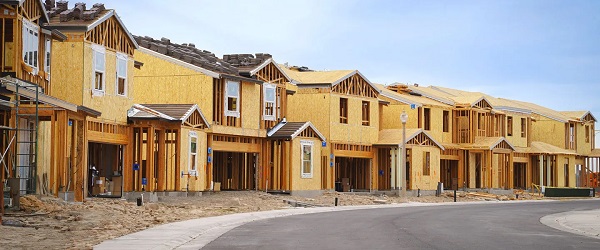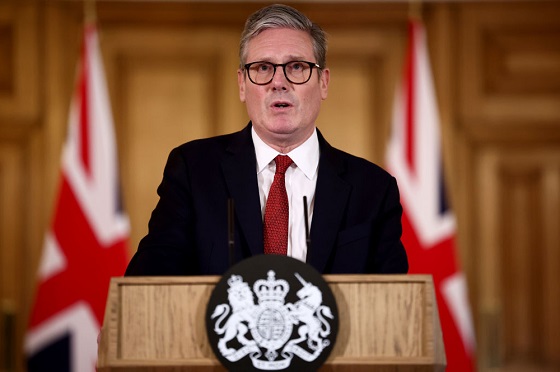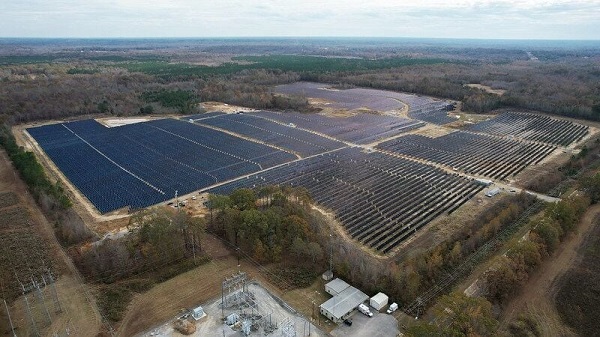Housing
PBO Refuses to Model Liberal Housing Promise

Liberals pledged to double housing construction (500,000 homes per year), But Parliamentary Budget Office Excludes It from Realistic Projections
You may have seen a new report from Canada’s Parliamentary Budget Officer—the same office that’s supposed to keep the government honest. It’s called “Household Formation and the Housing Stock: Estimating the Housing Gap in 2035.” Sounds technical? It is. Deliberately so. Because what it’s really doing is papering over one of the greatest policy-driven disasters in modern Canadian history.
You can read it—22 pages of graphs, footnotes, and soft-spoken bureaucratic lingo. But I’ll save you the time.
Here’s what it says:
Canada needs 3.2 million new homes by 2035 just to balance supply and demand. That’s 290,000 new homes a year. Every year. For 11 years straight.
From Immigration Surge to Housing Shortage
Let’s be clear: this didn’t just happen. This wasn’t an asteroid. This wasn’t climate change. This was government failure—Trudeau’s Liberals flooded the country with immigration without a plan to house anyone.
And now? Now they’re pretending to be surprised.
The Parliamentary Budget Officer just told us flat out: Canada will be short 690,000 homes by 2035 unless we add 3.2 million new units—that’s 290,000 completions per year, every year for the next 11 years.
But here’s the kicker: in 2024 alone, household formation hit 482,000 new households—the highest on record. And what did the housing stock grow by that same year? Just 276,000 units. That’s a gap of more than 200,000 homes in a single year.
Why? Demand outpaced Supply due to the Liberal policy on Immigration. In 2023, Canada brought in over 1 million newcomers when you count permanent residents, international students, and temporary foreign workers combined. But we didn’t build for them. We didn’t even try. Instead, Liberals told us to stop worrying—that the math would “work itself out.”
This is what happens when you run a country on slogans instead of arithmetic. The Liberals act like math is racist, like pointing out the obvious—that more people require more homes—is somehow offensive.
But the math doesn’t care about your feelings:
- 1 million people in.
- 276,000 homes built.
- 482,000 households formed.
You don’t need a PhD in economics to see the problem.
Meanwhile, the Canada Mortgage and Housing Corporation (CMHC) the federal housing agency staffed by bureaucrats says we actually need 5.3 million new homes by 2035 to restore affordability. That’s 478,000 completions per year. For context, the all-time Canadian record is 276,000 in 2024. In other words, they’re demanding we build almost double the best year in Canadian history every single year, for a decade.
And here’s the part no one in Ottawa wants to say out loud: even the Parliamentary Budget Officer admits the current pace is smoke and mirrors. Yes, completions will look strong for the next three years a little sugar high averaging about 256,000 a year. But after that? It falls right back to normal, around 227,000 units annually.
And if you actually want to close the gap? If you want to make up for the 690,000 homes Canadians will be short by 2035? The math is brutal: we’d need 290,000 completions every single year. Not once. Not twice. For eleven years straight. That means outperforming 2024’s all-time record the best year in Canadian history every single year until 2035.
And how do they want to do it? By deliberately overbuilding until the vacancy rate hits 13%. Their idea of “affordability” is to flood the country with so many empty units that prices collapse. They actually admit this would mean abnormally high levels of unoccupied housing units and households with second homes.
This isn’t serious policy. This is what happens when the only tool in your toolbox is a spreadsheet. Instead of asking the obvious question—maybe stop importing more people than you can possibly house—they double down on fantasy construction targets they’ve never hit and never will.
So the supply-and-demand math works out like this: Liberals open the floodgates on immigration, CMHC panics, and then Ottawa tells you the “solution” is to build ghost condos no one lives in.
Final Thoughts
Let’s remember who Mark Carney is. He’s not a carpenter. He’s not even an economist in the traditional sense. He’s a Davos guy, a former Bank of Canada and Bank of England governor with deep ties to Wall Street, Bay Street, and the World Economic Forum.
And now this is the man presiding over the very same government that created this crisis. Nothing has changed. No one has been fired. It’s the same Prime Minister’s Office, the same Liberal MPs, the same Ottawa swamp that told you for years everything was under control. They opened the immigration floodgates without building homes, they inflated demand, and now they stand around pretending to be shocked at the results.
And here’s the proof: the Parliamentary Budget Officer spells it out in black and white this government has completely decoupled housing from affordability.
“Our estimate is not linked to a targeted measure of affordability.”
What does that tell you? It tells you the people in charge of housing policy in Canada don’t even pretend to care if you can afford a home. Affordability isn’t even on the whiteboard.
And here’s the part that’s so insulting: they have the numbers. They know exactly how many people they’re letting into the country. They set the immigration levels themselves. In fact, by 2027, Ottawa projects non-permanent residents will make up 5.3% of Canada’s population. That’s millions of people—on top of permanent resident intake, on top of natural population growth.
They know how many households will form. They know how many housing completions are projected—227,000 a year on average through 2035. And they know how many are required to even come close to balance—290,000 a year.
So what’s the plan? The Liberals say they’re going to “double housing construction.” Sounds great, except the PBO wouldn’t even bother modeling it. Why? Because it isn’t credible. They treated it as a press release, not a policy.
Think about that: Canada’s independent budget watchdog looked at the government’s big campaign promise and said, essentially, “We’re not wasting time pretending this will happen.” That’s how unserious it is.
Meanwhile, you the ordinary Canadian are told it’s normal if you can’t afford a home to raise a family. Normal if you’re stuck in your parents’ basement until you’re 40. Normal if your dream of owning a modest house has been outsourced to hedge funds, pension managers, or foreign buyers.
The Liberals know the math. They have the data. They’re the ones opening the front door to record levels of newcomers while refusing to build at scale. They’re the ones who could slow intake to match supply but won’t. Because in their view, it’s perfectly fine if you never own anything.
And that’s the real scandal here. This isn’t some bureaucratic mistake. This isn’t a rounding error. Canada’s housing crisis is deliberate Liberal policy, dressed up as incompetence. The same Liberal MPs, the same Prime Minister’s Office, the same swamp creatures have been running this file for years, and they’re never held accountable. No one gets fired. No one takes responsibility.
So let’s stop pretending they’ll suddenly have a change of heart. They won’t. The only way these Liberals will ever change their tune is if Canadians vote them out and throw them out of power. Period.
Subscribe to The Opposition with Dan Knight .
For the full experience, upgrade your subscription.
Business
Carney’s housing plan will likely spend a lot for very little

From the Fraser Institute
By Jake Fuss and Austin Thompson
The Carney government recently released its plan for a new federal housing “entity” called Build Canada Homes (BCH). Unfortunately, the plan is rife with conflicting priorities and major risks. Without course correction, Canadians could end up spending more while seeing no real progress on the housing crisis.
BCH’s core mandate is to cut the cost of homebuilding. Yet the plan would require BCH to favour Canadian-made and “net-zero” or environmentally conscious products. These goals are at odds. If a product needs a government preference to be used, it’s not the most cost-effective option. BCH won’t deliver affordable housing if it’s shackled by competing mandates. Simply put, chasing unrealistic “net-zero” targets and propping up domestic industries will drive up building costs.
To boost construction, BCH plans to use taxpayer dollars to reduce the financial risks to housing developers by providing loans, loan guarantees and equity investments for homebuilding. But slow and costly municipal approval processes remain one of the biggest sources of investment risk for housing developers. For example, developers face a 25-month wait, on average, for municipal planning approval in Toronto (compared to just 3.4 months in Edmonton). Federal spending won’t solve this problem—it will simply paper over the problem with expensive subsidies. In other words, to reduce financial risk for housing developers, the Carney government plans to stick Canadian taxpayers with the risks and costs of BCH loans and investments that may fail or underperform.
With BCH, the Carney government is also betting big on modular housing, based on the untested assumption that if Ottawa “drives demand” costs will plummet. Skepticism is warranted. If modular housing truly delivered on its promises of being cheaper, why haven’t private housing developers leapt at the opportunity? A study by Canada’s federal housing regulator found that modular housing is “no silver bullet,” noting that cost savings were uncertain and modular construction faces unique challenges related to transporting large prefabricated sections and protecting materials from weather damage.
At its core, the BCH approach rests upon a flawed assumption that the private sector cannot provide enough affordable housing. But that’s ahistorical—Canada had broadly affordable housing in decades past, provided almost entirely by the private sector. In reality, more private housing would be built today if all levels of government simply got out of the way and reduced taxes on housing development, relaxed rules on what can be built and where, and provided shorter and more certain approval processes.
Instead, through BCH, the Carney government plans to pump federal dollars into a broken housing system. Due to the shortage of construction labour, BCH projects may compete with private development rather than add greatly to the overall stock of houses—all at considerable cost to taxpayers.
Canada’s housing crisis won’t be solved by new agencies or lofty promises. On the contrary—governments should step back and let the private sector build. Build Canada Homes is yet another misguided Ottawa experiment: expensive, overreaching and ineffective.

Austin Thompson
Business
Canada’s Real Estate Economy, Fueled by Mass Immigration and Offshore Cash, Is Unsustainable, Mayor Brad West Warns

Port Coquitlam Mayor Brad West meets with U.S. Secretary of State Antony Blinken in 2023 to discuss American concerns over fentanyl trafficking and money laundering tied to transnational crime groups operating in British Columbia.
“Billions upon billions” poured into land speculation have turned B.C. housing into a magnet for global money and mass migration, Mayor Brad West writes in an exclusive Op-Ed for The Bureau.
By Brad West
British Columbia, and much of the country, is confronting the consequences of an economic model that was never built to last. For years, we have been told a comforting story about growth — that as long as cranes dot the skyline and property values climb, prosperity will follow. But beneath that veneer lies a stark truth: our economy is not driven by value-added manufacturing, groundbreaking technology, innovation, or by unlocking our vast natural resource potential. It is built almost entirely on real estate and relentless population growth driven by mass immigration. And it relies on the building and selling of homes to the next wave of newcomers.
This is not diversification. This is dependency. And like all dependencies, it eventually demands a price.
In the not-too-distant past, B.C.’s prosperity came from sectors that created enduring value: forestry and mining that supplied the world; fisheries that sustained communities; manufacturing that turned raw materials into products; and, in more recent years, tech companies that could compete globally.
Today, those industries are shadows of their former selves in our economic mix — thanks, in part, to the strangulation of over-regulation and inordinately lengthy approval processes easily weaponized by those ideologically opposed to resource extraction. Their demise is not a naturally occurring phenomenon — and it is reversible — but it reflects the agenda and decisions of policymakers. In their place, real estate has become the dominant force, representing nearly 30 percent of B.C.’s GDP with its ancillary sectors. That’s a hell of a lot of eggs in a single basket, and the province’s balance sheet has become frighteningly tied to this cycle.
As the government oversaw this reorganization of the economy, it sent out the proverbial bat signal that investment capital didn’t belong in business development, but in land. Message received. Billions upon billions poured into bidding up land prices. Among the many consequences of this misallocation of capital are high land values squeezing out industrial employers and gnawing away at industrial land, weakening our capacity to make and export things. Today, industrial land makes up barely 4 percent of Metro Vancouver’s landmass.
Mass Immigration as Fuel for the Model
This new growth machine runs on people — specifically, the rapid influx of newcomers. In theory, immigration is a tool to strengthen an economy, replenish a workforce, and foster innovation. But in practice, B.C. and Canada have relied on it as the primary fuel for real estate demand. In 2023 alone, Canada added 1.27 million people — the most in 66 years, and almost entirely through immigration. No other G7 country comes close.
The country’s notorious Temporary Foreign Worker Program and unprecedented number of international students have figured prominently in this surge. Programs once intended to fill specific gaps or foster academic exchange have morphed into de facto population pipelines.
It’s all about feeding the beast: bring in more people than the market can comfortably absorb, then build and sell homes to meet the stimulated demand. Rising prices are framed as a sign of economic health, when in reality, they are a sign of scarcity and strain. In B.C., the government has clung to this model by throwing community planning out the window with legislation that overrides local decision-making and forces blanket upzoning without regard for infrastructure capacity or livability.
But all the smoke and mirrors in the world can’t obscure the reality. Hospital emergency rooms close not sporadically, but routinely. More and more students are educated in portables rather than properly resourced schools. Infrastructure — from roads and public transit to sewers and utilities — is under immense strain. It was never designed for the pace of expansion we’ve seen, and the costs of playing catch-up are staggering.
And still the cycle continues — because without that constant flow of new buyers, the whole structure starts to wobble. And wobbling it is.
Ponzi Economics: Why B.C.’s Housing Foundations Are Failing
To call this a Ponzi scheme is not to say it is literally fraudulent in the legal sense. But the comparison is apt: returns for current “investors” depend on recruiting new participants at ever-higher prices. The moment the influx slows, the math stops working.
We’ve seen this movie before. Jurisdictions from Ireland before the 2008 crash, to parts of Spain’s coastal boom towns, to U.S. “Sun Belt” cities in the lead-up to the subprime meltdown — all rode a similar wave. And when it broke, the fallout was severe: construction job losses, collapsing home values, public finances in crisis, and a wave of personal bankruptcies.
In B.C., the warning lights are already flashing. Housing sales have cooled. Developers are shelving projects. Construction employment, once a driver of job growth, is faltering. Debt loads — both personal and governmental — are dangerously high. In the case of the Government of British Columbia, that would be a historic $133 billion. Youth unemployment in the province reached 14.6 percent in July — the highest level since September 2010.
Meanwhile, the sectors that could cushion a downturn — manufacturing, technology, value-added resource development — suffer from the province’s unilateral disarmament.
Let’s be honest: status quo politicians have taken us too far down this road to turn back without consequence. The damage is already being felt — and more is coming. But that doesn’t mean we can stay the course. We must act deliberately, and with purpose, to shift away from an economic model where our primary export is real estate, toward one where we build and produce the goods, technology, and services the world actually needs.
The turnaround won’t be easy, and it won’t be quick. But the longer we wait, the higher the cost of inaction. That means unshackling our resource sectors from endless regulatory gridlock so they can innovate and compete. It means investing in productivity-enhancing infrastructure, research and development, and the skills of our own workforce. And it means having an honest conversation about immigration levels — balancing economic benefits with our capacity to house and integrate new arrivals without fueling a speculative frenzy.
B.C. can either confront these realities now, or wait until the market forces a reckoning upon us. One path allows for a managed, strategic shift toward long-term prosperity. The other leaves us at the mercy of the same “house of cards” economics that has collapsed elsewhere — only this time, we will have no one to blame but ourselves.
Brad West is the Mayor of Port Coquitlam, British Columbia.
-

 Business2 days ago
Business2 days agoU.S. rejection of climate-alarmed worldview has massive implications for Canada
-

 Business2 days ago
Business2 days agoMounties, Overstretched and Overmatched by Foreign Mafias, No Longer Fit for Service
-

 Crime2 days ago
Crime2 days ago8-year-old and 10-year-old killed in church pews, 17 others injured in shooting at Minneapolis Catholic church
-

 C2C Journal1 day ago
C2C Journal1 day agoHow Canada Lost its Way on Freedom of Speech
-

 Artificial Intelligence2 days ago
Artificial Intelligence2 days agoParents sue OpenAI, claim ChatGPT acted as teen’s “suicide coach”
-

 Business2 days ago
Business2 days agoTrump goes on attack over digital services taxes, threatens tariffs
-

 Daily Caller2 days ago
Daily Caller2 days agoTrump Team Floated Energy Incentives With Russia In ‘Sideline’ Ukraine Peace Talks
-

 Censorship Industrial Complex2 days ago
Censorship Industrial Complex2 days agoUK mother imprisoned over tweet says she was ‘political prisoner’ of Keir Starmer










